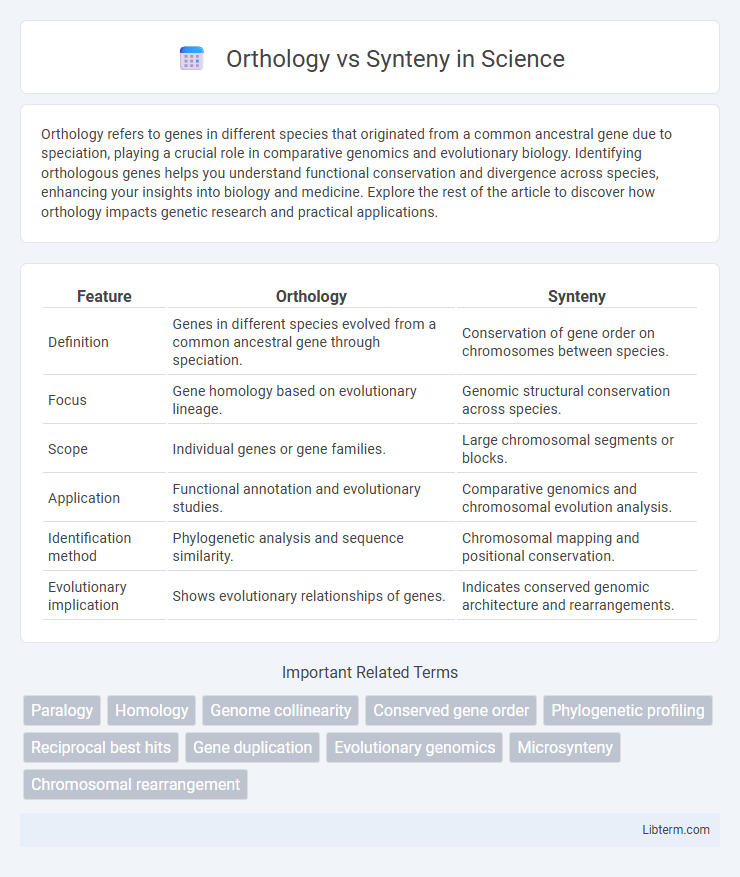Orthology refers to genes in different species that originated from a common ancestral gene due to speciation, playing a crucial role in comparative genomics and evolutionary biology. Identifying orthologous genes helps you understand functional conservation and divergence across species, enhancing your insights into biology and medicine. Explore the rest of the article to discover how orthology impacts genetic research and practical applications.
Table of Comparison
| Feature | Orthology | Synteny |
|---|---|---|
| Definition | Genes in different species evolved from a common ancestral gene through speciation. | Conservation of gene order on chromosomes between species. |
| Focus | Gene homology based on evolutionary lineage. | Genomic structural conservation across species. |
| Scope | Individual genes or gene families. | Large chromosomal segments or blocks. |
| Application | Functional annotation and evolutionary studies. | Comparative genomics and chromosomal evolution analysis. |
| Identification method | Phylogenetic analysis and sequence similarity. | Chromosomal mapping and positional conservation. |
| Evolutionary implication | Shows evolutionary relationships of genes. | Indicates conserved genomic architecture and rearrangements. |
Introduction to Orthology and Synteny
Orthology refers to genes in different species that have evolved from a common ancestral gene through speciation and typically retain the same function, making it a key concept in evolutionary biology and comparative genomics. Synteny describes the conserved order of genes on chromosomes across different species, providing insights into chromosomal evolution and genome organization. Both orthology and synteny are essential for understanding genetic relationships and evolutionary history in molecular biology.
Defining Orthology: Genes and Evolutionary Relationships
Orthology refers to genes in different species that originated from a common ancestral gene through speciation events, retaining similar functions across evolutionary lineages. These genes provide critical insights into evolutionary relationships by reflecting shared ancestry and functional conservation among diverse organisms. Analyzing orthologous genes enables researchers to trace gene function evolution and understand species divergence at the molecular level.
Understanding Synteny: Genomic Conservation Across Species
Synteny refers to the conserved order of genes on chromosomes across different species, providing insights into evolutionary relationships and genome structure. It highlights large-scale genomic conservation, contrasting with orthology, which focuses on homologous genes derived from a common ancestor. Studying synteny enables researchers to trace chromosomal rearrangements and better understand functional genome architecture in comparative genomics.
Key Differences Between Orthology and Synteny
Orthology refers to genes in different species that evolved from a common ancestral gene by speciation, maintaining similar functions, while synteny describes the conserved order of genes on chromosomes across species irrespective of gene function. Orthologous genes are identified based on sequence similarity and evolutionary history, whereas synteny involves the preservation of chromosomal segments and gene arrangement. Key differences include orthology's emphasis on gene homology and function, contrasted with synteny's focus on genomic context and structural conservation.
Importance of Orthology in Comparative Genomics
Orthology is crucial in comparative genomics as it identifies genes in different species that originated from a common ancestor, enabling accurate prediction of gene function and evolutionary relationships. Unlike synteny, which examines the conserved order of genes on chromosomes, orthology provides precise insight into gene homology and functional conservation across species. This distinction allows researchers to transfer biological knowledge between organisms and advance understanding of gene evolution and species divergence.
Role of Synteny in Genome Annotation
Synteny plays a crucial role in genome annotation by providing a framework to identify conserved gene order and structural features across different species, which aids in predicting gene function and validating orthologous relationships. Unlike orthology that focuses on gene sequence similarity and evolutionary conservation, synteny examines the preservation of gene clusters and chromosome segments, enhancing annotation accuracy through comparative genomics. Integrating syntenic block analysis improves the detection of genomic rearrangements and annotation of repetitive elements, leading to more reliable functional assignments and evolutionary insights.
Methods for Identifying Orthologs
Identifying orthologs involves comparative genomics methods such as sequence similarity searches using BLAST and clustering algorithms like OrthoMCL, which detect genes in different species derived from a common ancestor. Phylogenetic tree reconstruction further refines ortholog identification by distinguishing orthologs from paralogs based on evolutionary relationships. In contrast, synteny analysis supplements ortholog detection by examining conservation of gene order and chromosomal segments across species, enhancing the confidence in ortholog assignments.
Techniques for Detecting Synteny Blocks
Techniques for detecting synteny blocks primarily rely on comparative genomics approaches that identify conserved gene order and orientation across different species' chromosomes. Algorithms such as MCScanX use gene collinearity and sequence similarity to detect homologous regions, while tools like Cyntenator apply dynamic programming to align multiple genomes and reveal synteny blocks. These methods integrate genomic annotations, gene homology data, and statistical scoring to robustly map evolutionary conserved segments, distinguishing synteny from orthology focused solely on gene homology without positional context.
Applications of Orthology and Synteny in Evolutionary Studies
Orthology analysis enables the identification of genes in different species that originated from a common ancestor, facilitating the reconstruction of evolutionary relationships and the detection of functional conservation across lineages. Synteny, the preservation of gene order on chromosomes, provides insights into chromosomal rearrangements and genome evolution by comparing gene arrangements across species. Combining orthology and synteny data improves the accuracy of phylogenetic inference, gene function prediction, and understanding of genome architecture changes during speciation events.
Future Prospects in Orthology and Synteny Research
Future prospects in orthology and synteny research include leveraging advances in high-throughput sequencing and comparative genomics to enhance gene function prediction and evolutionary studies. Integrative approaches combining machine learning and large-scale genomic data promise improved accuracy in identifying orthologous genes and conserved syntenic blocks, facilitating insights into genome organization and species divergence. Emerging technologies such as single-cell genomics and pan-genomics are expected to further refine orthology assignments and uncover dynamic synteny patterns across diverse taxa.
Orthology Infographic

 libterm.com
libterm.com